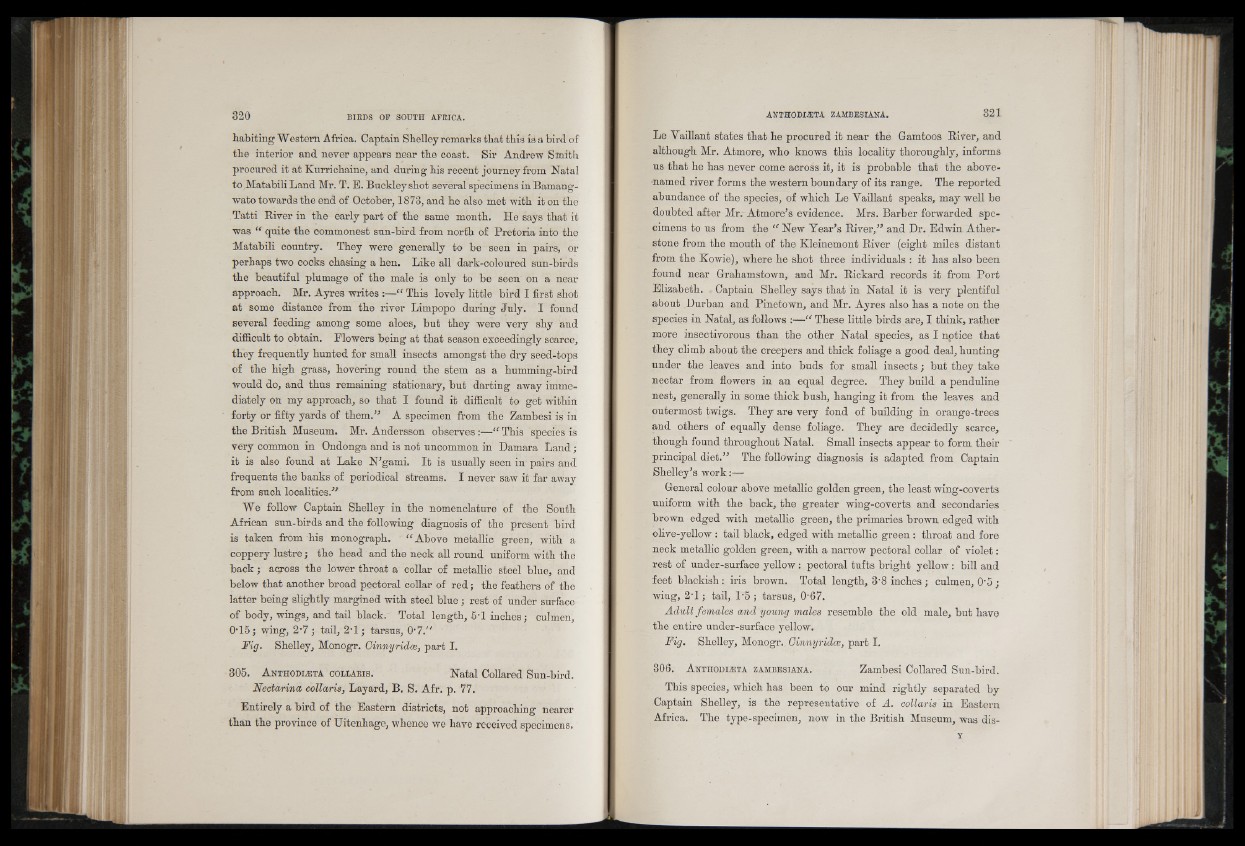
habiting Western Africa. Captain Shelley remarks that this is a bird of
the interior and never appears near the coast. Sir Andrew Smith
procured it at Kurrichaine, and during his recent journey from Natal
to Matabili Land Mr. T. B. Buckley shot several specimens in Bamang-
wato towards the end of October, 1873, and he also met with it on the
Tatti River in the early part of the same month. He says that it
was “ quite the commonest sun-bird from north of Pretoria into the
Matabili country. They were generally to be seen in pairs, or
perhaps two cocks chasing a hen. Like all dark-coloured sun-birds
the beautiful plumage of the male is only to be seen on a near
approach. Mr. Ayres writes :—“ This lovely little bird I first shot
at some distance from the river Limpopo during July. I found
several feeding among some aloes, but they were very shy and
difficult to obtain. Flowers being at that season exceedingly scarce,
they frequently hunted for small insects amongst the dry seed-tops
of the high grass, hovering round the stem as a humming-bird
would do, and thus remaining stationary, but darting away immediately
on my approach, so that I found it difficult to get within
forty or fifty yards of them.” A specimen from the Zambesi is in
the British Museum. Mr. Andersson observes :—“ This species is
very common in Ondonga and is not uncommon in Damara Land;
it is also found at Lake N’gami. I t is usually seen in’ pairs and
frequents the banks of periodical streams. I never saw it far away
from such localities.”
We follow Captain Shelley in the nomenclature of the South
African sun-birds and the following diagnosis of the present bird
is taken from his monograph. “ Above metallic green, with a
coppery lustre; the head and the neck all round uniform with the
back; across the lower throat a collar of metallic steel blue, and
below that another broad pectoral collar of red ; the feathers of the
latter being slightly margined with steel blue ; rest of under surface
of body, wings, and tail black. Total length, 5T inches; culmen,
0T5; wing, 2'7 ; tail, 2'1; tarsus, 0’7.''
Fig. Shelley, Monogr. Cinnyridce, part I.
305. A nthodueta collaris. Natal Collared Sun-bird.
Nectcmna collaris, Layard, B. S. Afr. p. 77.
Entirely a bird of the Eastern districts, not approaching nearer
than the province of Uitenhage, whence we have received specimens.
Le Vaillant states that he procured it near the Gamtoos River, and
although Mr. Atmore, who knows this locality thoroughly, informs
us that he has never come across it, it is probable that the above-
•named river forms the western boundary of its range. The reported
abundance of the species, of which Le Vaillant speaks, may well be
doubted after Mr. Atmore’s evidence. Mrs. Barber forwarded specimens
to us from the “ New Tear's River,” and Dr. Edwin Ather-
stone from the mouth of the Kleinemont River (eight miles distant
from the Kowie), where he shot three individuals : it has also been
found near Grahamstown, and Mr. Rickard records it from Port
Elizabeth. ■ Captain Shelley says that in Natal it is very plentiful
about Durban and Pinetown, and Mr. Ayres also has a note on the
Species in Natal, as follows :—“ These little birds are, I think, rather
more insectivorous than the other Natal species, as I nptice that
they climb about the creepers and thick foliage a good deal, hunting
under the leaves and into buds for small insects; but they take
nectar from flowers in an equal degree. They build a penduline
nest, generally in some thick bush, hanging it from the leaves and
outermost twigs. They are very fond of building in orange-trees
and others of equally dense foliage. They are decidedly scarce,
though found throughout Natal. Small insects appear to form their
principal diet.” The following diagnosis is adapted from Captain
Shelley's work:—
General colour above metallic golden green, the least wing-coverts
uniform with the back, the greater wing-coverts and secondaries
brown edged with metallic green, the primaries brown edged with
olive-yellow : tail black, edged with metallic green : throat and fore
neck metallic golden green, with a narrow pectoral collar of violet:
rest of under-surface yellow : pectoral tufts bright yellow: bill and
feet blackish : iris brown. Total length, 3*8 inches ; culmen, 0-5 ;
wing, 2*1; tail, P5 ; tarsus, 0-67.
Adult females and young males resemble the old male, but have
the entire under-surface yellow.
Fig. Shelley, Monogr., Cinnyridce, part I.
306. A nthodusta zambesiana . Zambesi Collared Sun-bird.
This species, which has been to our mind rightly separated by
Captain Shelley, is the representative of A. collaris in Eastern
Africa. The type-specimen, now in the British Museum, was dis-
Y